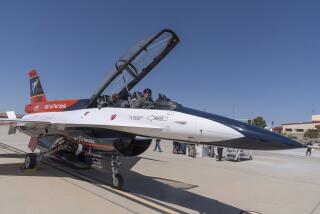Postcard From the Future Raises Hackles in Congress
- Share via
WASHINGTON — The postcard looks like it was slipped into the magazine by accident. It’s a note home from ‘Katie,’ a front-line soldier telling her husband and son not to worry about an impending battle.
Then a closer look shows the date, June 18, 2007. The note to ‘Rick and the Jakester’ is a work of fiction by the defense contractors who build the F-22 fighter and want the government to spend billions on it in the coming decades.
“Everyone in the battalion is pretty tense,” Katie writes. But she adds, “You guys shouldn’t worry. . . . We know what we’re doing. We also have those F-22s upstairs totally ruling the sky and covering us like Jake’s big fuzzy blue blanket.”
The picture side of the postcard, which is glued to the magazine as part of a four-page F-22 spread, shows a young woman in helmet and camouflage surveying a desert landscape from the turret of a Humvee.
Glossy ads in publications read by senators and congressmen, senior staffers and Pentagon decision-makers are nothing new in Washington. But the ad by Lockheed Martin Corp., Boeing Co., and Pratt & Whitney takes the effort to a new level.
“It borders on being sick, in my opinion,” Sen. Dale Bumpers (D-Ark.) told top Air Force officials at a Senate Appropriations defense subcommittee hearing last week. “You can always tell when a weapons system is in trouble.”
Bumpers was referring to the long-standing practice among defense contractors of heavy ad campaigns for their weapons in Washington-area publications. Weapons at risk of being cut out of the budget seem to get particularly heavy play.
“It’s really an inside-the-Beltway phenomenon. You don’t see these ads in Cleveland,” said Erik Pages, vice president of Business Executives for National Security, a Washington-based business group. Typically in these ads, “Gee-whiz technology and hyper-patriotism are the two common themes.”
The pitch in the F-22 ad is straightforward enough: Buy this plane and it will save lives. What is unusual is the number of hot buttons the ad pushes.
* Ads for weapons rarely if ever mention casualties. This one addresses directly the aversion in the military and the American public generally to battlefield casualties.
* The depiction of a female soldier holding a hatch-mounted .50-caliber machine gun runs against current Army policy, which bars women from ground combat positions as part of infantry, armored or artillery units.
* The form of a letter home to spouse and children points to the increasing number of active-duty officers and enlistees who are married.
“I want it to be noticed,” said Lockheed Martin spokesman Doug Oliver. “You look for something that breaks out of the clutter.”
The ideal scenario envisioned by the contractor team is a member of Congress rushing from Capitol Hill to catch a plane and grabbing a copy of Time magazine on the way out the door.
President Clinton is seeking $2.2 billion for the F-22 in the proposed defense budget for next year. But the Pentagon last week said it now plans to buy 339 of the radar-evading fighters, down from the previous plan to buy 438. The planes will cost about $108 million each.
The defense contractors--some of the nation’s largest weapons-making firms--are buying ads in Time magazine’s Washington edition, the Washington Post and Roll Call and Congressional Quarterly, two publications that circulate widely on Capitol Hill. Oliver declined to disclose the campaign’s budget, other than to say it is “not huge by advertising industry standards.”
The ad was created by DDB Needham of New York. Oliver said the budget for the ad is coming out of profits of the defense contractors and is not part of the cost being billed to the government.
More to Read
Get the L.A. Times Politics newsletter
Deeply reported insights into legislation, politics and policy from Sacramento, Washington and beyond. In your inbox twice per week.
You may occasionally receive promotional content from the Los Angeles Times.










